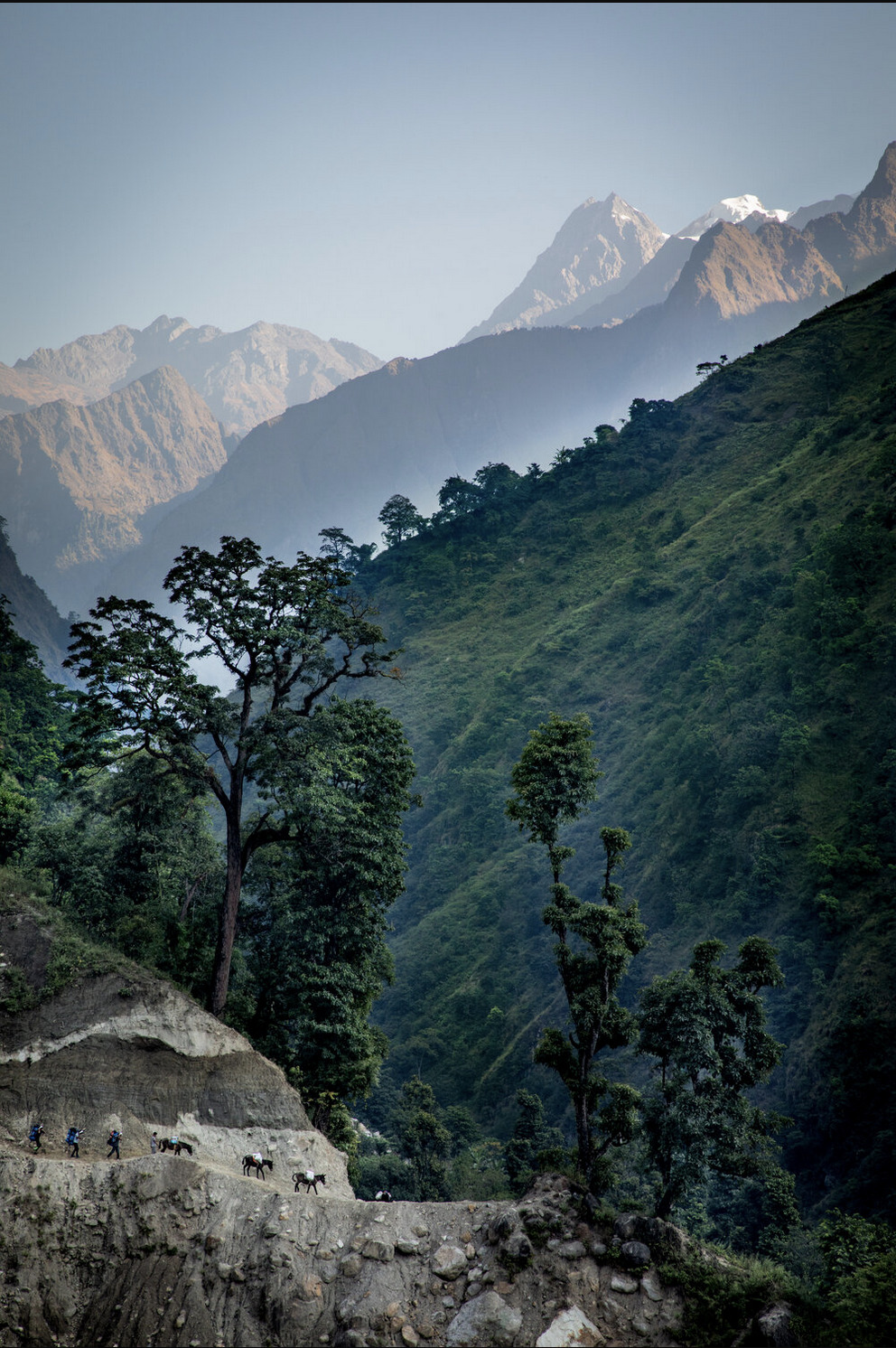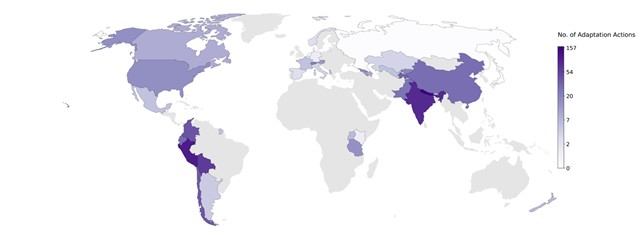Adaptation action and research in glaciated mountain systems: Are they enough to meet the challenge of climate change?

Introduction
Climate change has arrived for glaciated mountain systems, with major reductions in glacier cover, changes in hydrological dynamics, amplified geohazards, and unusual ecological patterns observed across many high mountain areas. However, despite widespread observations of climate-related changes, understanding of how climate change is actually affecting mountain people remains limited.
This paper focuses on human adaptation while remaining attentive to the broader socioecological implications of human responses to climate change. It contributes to a small but growing literature on adaptation to climate change in mountain regions, using formal systematic review methods and an integrative theoretical framework to critically evaluate adaptation action and research in light of the challenge posed by climate change in glaciated mountain systems.
It engages with the following research question:
- What do we know about adaptation action and research in glaciated mountain systems, and are observed efforts enough to meet the challenges of climate-related changes?
- What are the consequences of shortcomings in these efforts, and what changes are needed to more fully meet the challenge of climate change in glaciated mountain systems?
*Download the publication from the right-hand column. The key messages from the publication are provided below. See the full text for much more detail. *This chapter is adapted from an article published in the journal Global Environmental Change. McDowell, G., Huggel, C., Frey, H., Wang, F., Cramer, R., Ricciardi, V. (2019) Adaptation action and research in glaciated mountain systems: Are they enough to meet the challenge of climate change? Global Environmental Change. 54: 19-30
The Challenge of Climate Change in Glaciated Mountain Systems
The paper sets out three main challenges of climate change in glaciated mountain systems. These challenges bring together core themes from fields working on climate change in mountain systems, providing a common-sense framework for conceptualizing the challenge of climate change vis-à-vis adaptation action and research. Please refer to Adaptation to Glacio-Hydrological Change in High Mountains (Chapter 2) to learn more about the these three challenges.
- The high sensitivity of glaciated mountain systems to changes in temperature and precipitation combined with the rate and magnitude of climate change poses a major challenge for adaptation. The need to understand and address observed and projected biophysical changes without historical precedence is a key challenge posed by climate change in glaciated mountain systems.
- Climate-related changes are mapped onto diverse social, economic, and cultural settings, where characteristics reflect the nexus of specific geographies and socio-political histories in (and beyond) mountain regions. Consequently, the need to recognize, understand, and respond to the inherently social nature of exposure sensitivity, adaptive capacity, and vulnerability is a key challenge posed by climate change in glaciated mountain systems.
- Socio-ecological resilience literature highlights interdependencies, feedbacks, and tradeoffs between people and ecosystems in times of system change. Hence, the need to recognize, understand, and attend to the cascading effects of human adaptation on broader socio-ecological dynamics is another key challenge posed by climate change in glaciated mountain systems.
Methods and Tools
This study used a formal systematic review methodology to characterize adaptation action and research in glaciated mountain systems. Systematic reviews are focused assessments of the literature that use pre-defined eligibility criteria for documents and clearly outlined methods to answer specific research questions.
The data source for this study was information reported in peer-reviewed and grey literature documents published over a 25-year period that we define as the modern era of mountain research and development (June 1992 – December 2017). In total, 5646 documents (peer-reviewed + grey literature returns) were considered for this review.
Results were calculated for:
- All peer-reviewed and grey literature documents meeting the inclusion criteria (1. A peer-reviewed journal article or a grey literature document, 2. Published between 1 June 1992 and 31 December 2017, 3. Written in English, 4. Focused on contemporary human adaptation to experienced or anticipated effects of climate change, and 5. Conducted in or focused on adaptation in glaciated mountain areas).
- Peer-reviewed documents that were explicitly framed as mountain focused adaptation assessments.
Key Messages
The key findings from this study are as follows:
- The study results indicate that socially-relevant climate-related changes are already manifesting in glaciated mountain systems, with the most commonly documented stimuli for adaptation being hydrological changes related to the degradation of the high mountain cryosphere.
- The study documented some level of adaptation action in the majority of the countries with glaciated mountain ranges, although most actions are concentrated in the Himalayas and Andes (with adaptations involving agricultural and water-related sectors being most common).
- Increasing engagement from the international community was observed and may signal a shift towards more formal, forward-looking adaptation planning.
- The study also identified the emergence of explicitly mountain-focused adaptation research, yet studies framed in this way are still relatively scarce and have only been carried out in around half of the countries with glaciated mountain ranges.
Shortcomings in meeting the scientific, human, and socio-ecological challenges of climate changewere conspicuous. Despite encouraging progress, actions and research do not meet the challenges of climate change:
- Important shortcomings were documented with respect to the scientific, human, and socio-ecological challenges of climate change in glaciated mountain systems.
- Evidence of engagement with the interwoven nature of these challenges remains elusive, with most actions and assessments being focused on only one or two challenge areas.
- Although the number of countries with adaptation actions and assessments is growing, the majority of work is concentrated in the Himalayas and Andes (see figure below).

Ways Forward
Steps that must be taken to remedy the current situation:
Challenge 1: Scientific dimensions of climate change
Action
- Increase the integration of scientific information in adaptation planning processes.
- Complement scientific assessments with observations from mountain residents familiar with local environments.
- Acknowledge that detailed information about climate-related changes is important but not sufficient for effective adaptations.
Research
- Strive for deeper engagement with nuanced, scale-appropriate assessments of current and projected climatic changes.
- Clarify information needs for colleagues in the natural sciences.
- Foster knowledge sharing between adaptation researchers and other stakeholders with knowledge about climate-related changes.
Challenge 2: Human dimensions of climate change
Action
- Recognize the broader political economy of adaptation when planning adaptations.
- Aim to address the causes and consequences of differential vulnerability, including through transformative adaptations.
- Ensure that adaptation planning processes are inclusive, open-minded, and fair.
Research
- Increase engagement with the human dimensions of climate change.
- Aim to move away from environmentally deterministic narratives about vulnerability and adaptation through place-based assessments that involve mountain populations.
- Expand repertoire of theoretical, analytical, and methodological tools used in adaptation assessments
Challenge 3: Socio-ecological dimensions of climate change
Action
- Encourage adaptation planning processes that consider how human adaptations influence and are influenced by socio-ecological dynamics.
- Utilize understanding of socio-ecological dynamics to avoid maladaptation and to devise more sustainable adaptations.
- Draw on complementarities between local knowledge and scientific studies when characterizing system dynamics.
Research
- Explicitly evaluate how human adaptations influence and are influenced by socio-ecological dynamics.
- Expanded engagement with concepts and methods from socio-ecological resilience literature.
- Explore diverse scenario and systems modeling approaches.
General recommendations
Action
- Address remaining geographical gaps in adaptation action.
- Cultivate participatory, forward looking adaptation planning processes.
- Strengthen engagement with the sustainable mountain development paradigm Increase monitoring and evaluation efforts.
Research
- Address large geographical gaps in adaptation research.
- Embrace transdisciplinary research approaches.
- Strengthen engagement with the sustainable mountain development paradigm.
- Support monitoring and evaluation efforts.
Limitations of the Study and Research Needs
- The study only reviewed English-language documents and a subset of the (potentially) relevant grey literature.
- Limitations common to all systematic reviews: relevant documents may have been missed; findings are based on reported information, which is assumed to be a thorough and accurate reflection of the phenomena interest; and data extraction is affected by some level of researcher subjectivity.
- While the themes addressed in our definition of ‘the challenge of climate change’ highlighted several important issues for adaptation action and research, the definition is not comprehensive
Needs and opportunities in adaptation action and research
Key needs for adaptation action and research include:
- Increasing the integration of scientific information in adaptation planning processes.
- Recognizing the broader political economy of adaptation when planning adaptations.
- Encouraging adaptation planning processes that consider how human adaptations influence and are influenced by socio-ecological dynamics.
Suggested citation
McDowell, G., Huggel, C., Frey, H., Wang, F., Cramer, R., Ricciardi, V. (2019) Adaptation action and research in glaciated mountain systems: Are they enough to meet the challenge of climate change? Global Environmental Change. 54: 19-30.

Comments
There is no content